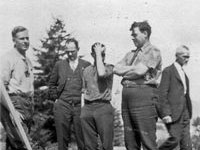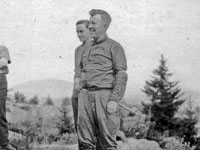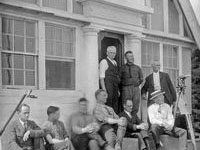

Stellarfane Gatherings
Annual 'Celebrations' before the first Convention
by Matt Considine, STM
While Stellafane as a convention dates to 1926, it's roots actually go back further than that. In September 1920, the first class of mirror makers was formed, with Russell Porter leading sixteen others in the building of amateur telescopes. Subsequent to the class forming, the group exhibited their efforts at the Springfield Fair, as noted in the Springfield Reporter on August 25, 1921. The paper also noted the outings to Mount Ephraim and Hawks Mountain in September of that year.
But class members did not restrict themselves to outdoor activities. For example, the local paper periodically reported on monthly meetings at various participant's homes. "Indoor" meetings first began in November of 1921, with three other meetings taking place that winter (For example, the January 1922 meeting at Carlton Damon's house was reported as the Damon's entertaining "Porter's group of telescope-makers [...] in a manner quite beyond the deserts of the men composing the association, which is held together by no bonds of the red-tape kind belonging to cut-and-dried organizations.")
Other meetings took place throughout 1922, 1923 and 1924. In July, 1924, the paper reported on the construction of the club's observatory the prior Fall, as well as the visit of Webb Waldron and his wife, who wrote about his meeting with the telescope makers in Colliers and other publications. The club's activities eventually captured the attention of Albert Ingalls of Scientific American, who showed up the next year, at the 1925 'gathering' reported in the June 18 issue of Springfield Reporter transcribed below. Note that at this time, the clubhouse was called Stellarfane, the 'r' not having been dropped yet.
|
Springfield Reporter 1925-Jun-18 ASTRONOMERS VISIT LOCAL TELESCOPERS. Scientific American Representative Is Guest of Telescope Club. |
|
|
The fifth annual celebration of the Springfield Telescope Makers, June 12-13, was the occasion for entertaining more or less distinguished guests. Mr. Albert G. Ingalls, special writer in scientific subjects for the Scientific American, spent two days and two nights with the club, dividing his time somewhat to visit Mr. Porter's laboratory at Jones & Lamson Machine company, and Mr. Hartness' now famous underground observatory. Two other guests were also present Saturday afternoon and night: Professor George N. Bauer, department of mathematics and astronomy of New Hampshire State College, who came at the special invitation of the club through Prof. Pierce of the Springfield Co-operative course; and Mr. R. M. Wilson, of the U. S. Geological Survey, with his assistant, R. W. Walton. Mr. Wilson's visit was the result of a unique train of events. A week earlier he made a visit to the Hawks mountain station in the interest of the primary triangulation work which he is conducting this summer to complete the geological survey work for the state of New Hampshire, this comprising the Claremont Quadrangle principally. On his arrival at the Hawks mountain station he discovered the tower and the bronze tablet which had been placed there September 24, 1921, by the Springfield Telescope Makers, in the club's re-occupation of the original survey station made by the government, about 50 years ago. Russell W. Porter, the club's president, had previously located the station, which was subsequently suitably marked as stated. Mr. Wilson at once drove to Springfield where he made inquiry for the Springfield Telescope Makers. He was referred to Mr. Hartness, who directed him to Stellarfane where he arrived just as Mr. Porter and Messrs. Fullam, Redfield and Pierce were eating their evening meal. Mr. Wilson introduced himself and it was not long before the sharp axes of the two veteran surveyors had limbed out all obstructions to an intimate acquaintance. Both Mr. Porter and Mr. Wilson have done work in Alaskan territory, and this alone was sufficient to establish mutual relationships. Accordingly Mr. Wilson and his assistant were urgently requested to be on hand at the club's coming meeting. Friday evening the club was entertained at the home of O. S. Marshall, where the members, with Mr. Ingalls, were shown several interesting stellar objects through Mr. Marshall's 8-inch reflecting telescope. The optical arrangement of this instrument is of unusual design, the work of Mr. Porter, and is the only instrument of its kind that has ever been made. Mr. Marshall has lately been completing certain adjustments to make the |
instrument function accurately when locating objects to be viewed in the evening skies, and the visitors were promptly shown such objects as nebula, double stars and star clusters, not to mention the two planets, Jupiter and Saturn, which are now in favorable position in our evening skies for observation. Saturday afternoon and night the club with its guests spent at Stellarfane where several equatorial telescopes were in service for the night's work. Messrs. Lyon, Whitney, Damon, Fullam, Redfield and Pierce had their instruments in good working order and members and guests made frequent use of them. Excellent seeing conditions prevailed, particularly Friday evening. Mr. Wilson made numerous observations from Stellarfane which will be used later when the government resumes its work for the final cleaning up of the geological survey in this portion of Vermont. This, Mr. Wilson explained, will depend largely on the interest which Vermont herself exercises in having the work completed. Vermont is behind all the rest of New England in this respect. The Claremont quadrangle when completed will include a good part of Springfield village, somewhat north and west of Mr. Marshall's place on Wall street, at least. Mt. Ephraim will be occupied sometime this present week by Mr. Wilson and will therefore be a station in the primary triangulation work of the government for this section. This, with Hawks mountain and Stellarfane, will make three stations with bronze markers in our vicinity, to be used by the topographers when they enter our territory for the final mapping of Vermont. Mr. Porter has recently installed a transit instrument for time taking at Stellarfane, and this was of great service to Mr. Wilson in furnishing him essential data to establish local longitude. The assemblage disbanded Sunday morning, and Mr. Ingalls departed with an abundance of material for his article on how amateurs can build equatorially mounted reflecting telescopes. His article will appear in the Scientific American sometime during the autumn or early winter months. A great many publications are reviving the custom of printing regularly monthly sky maps, along with popular material on astronomy and astronomical instruments. The local club has received numerous requests for information about how to make a telescope, as a result of the liberal notices that leading publications have taken of Mr. Porter's activities since he has permanently established himself in his original home town. It is with the end in view of spreading the gospel of astronomical knowledge and how to make instruments therefore that Mr. Ingalls was assigned to visit the Springfield Telescope Makers. |



The three photos above were identified as being taken at the 1925 gathering, due to the presence of Albert Ingalls and Oscar P. Fullam. Unfortunately, Oscar Fullam, an original club member, died in January 1926, while the first convention was in early July of that year. The earliest known date of Albert Ingalls visiting Stellafane was 1925. Because both of these men are present in these photos, they must be from the 1925 Gathering.
Back to the Early History Page